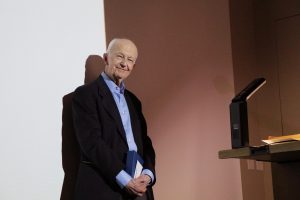By: Martyn Wendell Jones
Bishop Paul Tighe opened his May 16 lecture “The Church and Contemporary Art” in Alumni Hall with the images of three abstract paintings. He referred to the first of these to vindicate himself in a decades-old quarrel. As a child, he received a scolding from his art class teacher, Mother Immaculata: “You can’t put blue and green together; they don’t go,” she told the young Tighe. The first painting to appear on the wall during the fifteenth annual Christianity and the Arts Lecture was Mark Rothko’s “Green, blue, green on blue” (1968), and this served as the Bishop’s rebuttal.
Bishop Tighe is the Adjunct Secretary of the Pontifical Council for Culture in Rome, and something of an autodidact in matters of art. (At one point he described his educational journey as taking him “from cocksure ignorance to thoughtful uncertainty.”) He also is also the mind behind the Vatican’s social media strategy.
“The Church needs artists,” Tighe said. He described his mandate with the Council for Culture as related to the Pope’s encouragement to foster a “culture of encounter” and mutual curiosity between the Church and the art world.
The bishop surveyed papal discourses concerning art, finding in the words of all recent popes a warmth and love for the arts and a concern for beauty. He described the historical alliance between the Church and the arts that allowed for the creation of works of historical import. These pieces often imparted doctrinal truths to viewers and audiences who were otherwise barred from the study of theology by their inability to read.
Though the modern era is marked by a disjunction between the worlds of Catholicism and the arts, Bishop Tighe argued that Vatican II marked a new openness to art in the Church’s relationship with the world. He quoted several popes on art, which they variously called “expressive of the human condition” and something that “wakes people up” and “jolts us into wonder.”
While art can prepare a person for experiencing God and becoming receptive to the teachings of the Church, theology can also incline members of the Church towards art with its primary affirmation of the goodness of creation. Bishop Tighe emphasized this point by quoting Catholic priest and poet Gerard Manley Hopkins: “the world is charged with the grandeur of God.”

At the end of his lecture, Bishop Tighe offered a gift to Father Dan Donovan, who was on the cusp of his 80th birthday. Father Donovan is well known in the St. Mike’s community for his decades of service as a priest and professor, as well as for acquiring the roughly 400 pieces of contemporary art that are found across campus. In 2009, Pope Benedict—who, while still Cardinal Ratzinger, was once a teacher of Father Donovan’s—had 300 medallions created for a meeting with artists at the Sistine Chapel. Not every artist was in attendance, and some of the medallions were saved. Bishop Tighe presented Father Donovan with one of these medallions in honour of his 80th birthday.
President David Mulroney then gave the first of three speeches to celebrate Father Donovan’s unique contributions to the University of St. Michael’s College. The crowd of 300 broke into “Happy Birthday” twice, once at the urging of one of the speakers and once before Father Donovan was asked to cut his cake. When he was asked to go to the podium to speak, Father Donovan received a standing ovation.
In his own remarks to those gathered for the lecture and reception, Father Donovan emphasized his gratefulness. “Living is a good thing—something precious,” he said. Gratitude was the dominant theme in his reflections as he approached the age of 80, and this he attributed in part to his regular celebration of the Eucharist.
Martyn Wendell Jones is a writer in the Office of Communications at the University of St. Michael’s College
